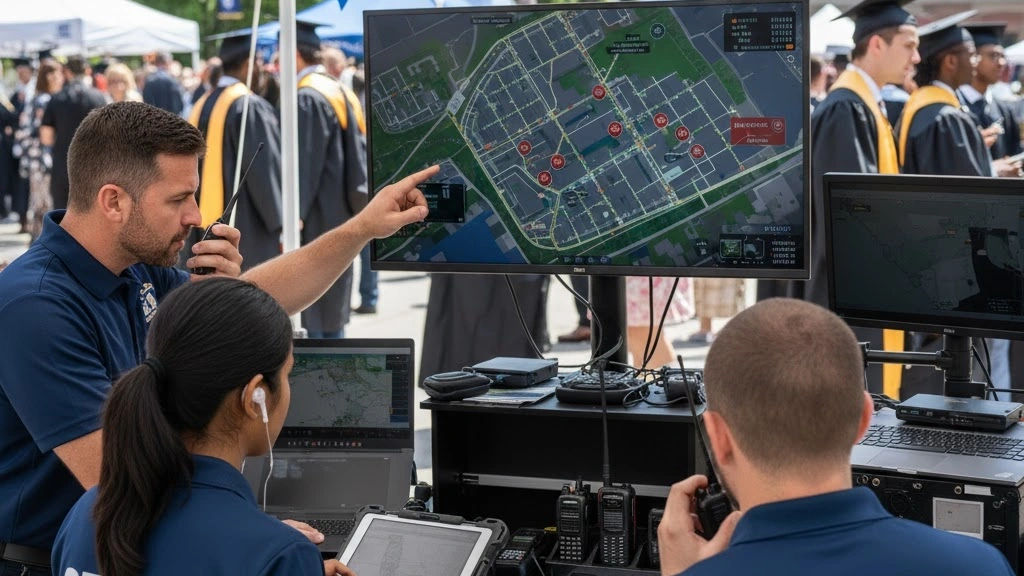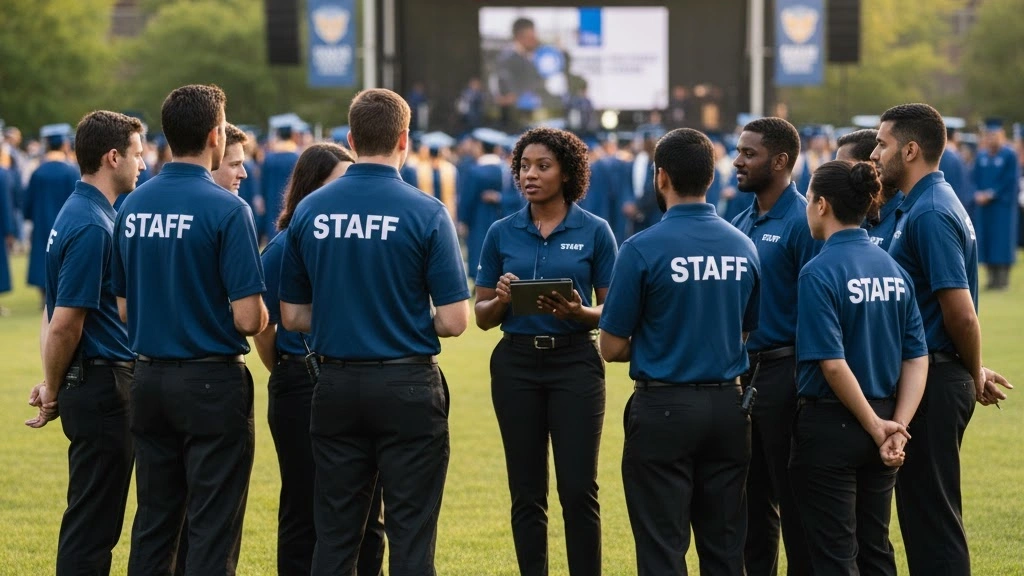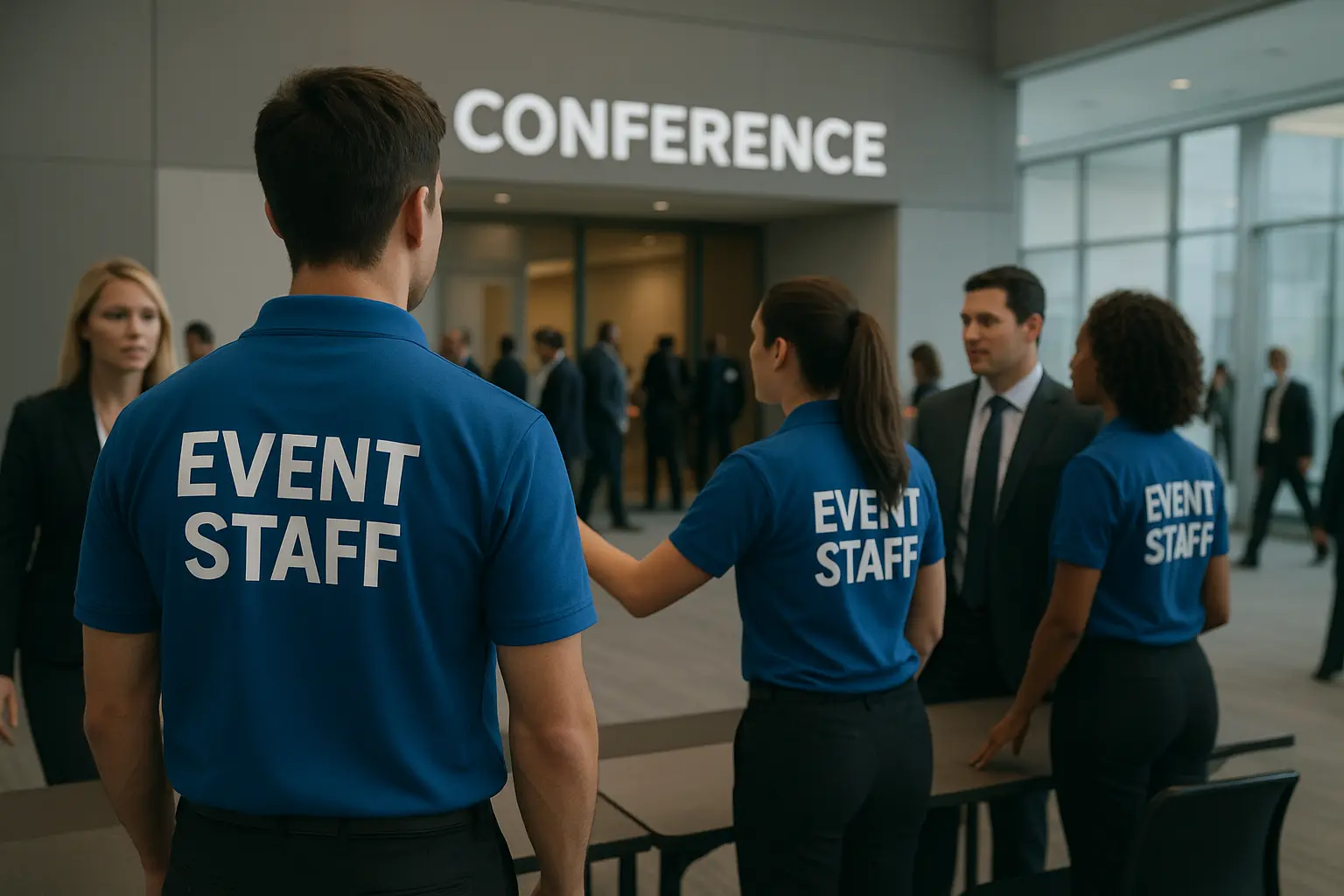A single university commencement can draw 5,000 graduates and 20,000 guests, turning a campus into a temporary city that runs on precision staffing. This is a high-stakes institutional moment. The operational stakes, including safety, security, and ADA compliance, as defined by industry leaders like the Event Safety Alliance, are as high as the emotional stakes for proud families, media, and VIPs.
This guide is an operational briefing on commencement staffing. We'll move beyond simple headcounts to cover the systems and deployment models required to manage the unique challenges of U.S. graduations. This is the blueprint for successful commencement staffing.
CEO EXCERPT
Commencement staffing is a zero-failure mission. It demands a unique system that blends operational precision with genuine human empathy. We provide that system, teams trained to manage complex logistics while ensuring every single guest feels recognized and safe.
-CEO Event staff
The Event Within an Institution: Why Commencement Staffing is Unique
Graduations are more complex than other large-scale event staffing operations. They blend rigid ceremonial structure with the open logistics of a public event.
- Mixed Demographics: The guest-facing side of commencement staffing must be prepared to manage a massive demographic range, from elderly guests with mobility needs to young children.
- Shared Command: Operational control is shared between the university, local authorities, vendors, and the staffing agency. A clear command structure is vital.
- Reputational Stakes: A single protocol error, a misdirected VIP, a chaotic graduate line, or a poorly handled ADA request reflects directly on the institution's reputation. Excellence in commencement staffing is non-negotiable.
The System of Roles: A Functional Deployment Model
Successful commencement staffing is a system of layered, specialized roles, not just a headcount. Each role has a distinct function within the operation.
Access Control & Ingress Teams:
This team manages all entry points, credential checks, and bag checks. They are the first touchpoint and are critical for security and maintaining a smooth flow.
Ushers & Guest Services:
This is the core of the guest experience. Staff in this role manage seating sections, assist guests with questions, and control concourse flow. This is a core way professional staff elevate the guest experience.
Stage & Graduate Procession Teams:
This is the most precise part of university event logistics. This team coordinates the graduate lines, faculty flow, and the diploma handoff sequence.
VIP & Protocol Staff:
This team manages dignitaries, board members, and donor guests, requiring a higher level of training in etiquette and discretion.
ADA Support & Mobility Teams:
A critical component for an inclusive event, this team manages all accessibility seating, golf cart shuttles, and guest escorts.
Parking & Transportation Staff:
This team manages the massive traffic and parking volume, which is often the first and last pain point for all guests.

The Pre-Deployment Framework: Setting the Standard for Success
A flawless commencement staffing deployment is defined by the planning that happens weeks before the event. A successful operation is built on a clear, documented framework that ensures every team member understands their role and position.
- Site Mapping & Zone Design
The first step is to divide the entire campus, from parking garages to the main stage, into distinct operational zones (e.g., Ingress, Concourse, Seating, Stage, Egress). Each zone is assigned a dedicated Zone Lead who manages all staff and operations within that specific footprint.
- Shift Timing & Briefings
Staggering call times for morning, midday, and evening ceremonies is essential for managing staff energy, performance, and overtime. We mandate pre-event walk-throughs with all supervisors and client leads to ensure 100% alignment on the plan.
- Uniforms & Identification
Consistency in uniforms is crucial for building guest trust and ensuring staff are highly visible for security and directional questions.
Using mobile check-in for staff attendance and a clear radio/Slack channel plan with pre-set escalations is vital for complex university event logistics. This ensures your command center has a real-time view of all assets.
For example, a 25,000-attendee ceremony might require 200 staff across 6 zones. This level of large-scale event staffing requires precision planning from the start.

The Human Factor: Psychology & Empathy in Commencement Staffing
Staff behavior is what ultimately defines the guest experience. Professional commencement staffing must blend operational authority with genuine human empathy.
- Assertive but Warm Tone
Guests at a graduation are often emotional and easily confused in a large, unfamiliar venue. Staff must be trained to give clear, assertive directions (e.g., "This aisle is for graduates only; guest seating is to your left") with a warm, celebratory, and reassuring tone.
- Managing Guest Emotion
It's key to train staff to recognize guest anxiety. The parent at the gate isn't "impatient"; they are anxious about missing their child's name being called. Staff must be trained to de-escalate with empathy ("I understand completely; we are going to get you inside right now"), not robotic commands.
- Bilingual & Cultural Awareness
On diverse campuses, bilingual greeters at key "decision nodes" (where guests must choose a direction) can reduce confusion and anxiety by over 50%. This kind of Cultural Awareness, understanding the specific needs of your audience, is a key part of modern commencement staffing.
Cost & Resource Planning for Commencement Staffing
Budgeting for professional commencement staffing requires a clear understanding of the key cost drivers that influence your final proposal.
Key cost drivers typically include:
- Early call times and extended shifts (often 10-12 hours), which may include overtime.
- Premium rates for bilingual staff or those with specialized medical/safety certifications.
- Supervisor and Captain rates (a 1:10 ratio is ideal for critical zones).
- Budgeted time for any mandatory, event-specific training for VIP protocol or ADA support.
To illustrate, a 15,000-guest ceremony typically needs 100–120 active staff plus 10 supervisors. For a full-day deployment, this represents a significant, but necessary, investment in operational excellence.

Common Pain Points & How to Prevent Them
Most commencement staffing failures are predictable and, more importantly, preventable with the right operational controls and foresight.
Pain Point 1: The ADA Choke Point
This common failure is caused by too few escorts or poorly marked accessible seating, leading to guest frustration and non-compliance. As the ADA guide on venue accessibility mandates, a clear plan is required.
- Control: We deploy a dedicated ADA lead and maintain a strict 1:5 staff-to-guest ratio for mobility assistance, with a separate dispatch for shuttles.
Pain Point 2: The Egress Gridlock
All 25,000 guests try to leave at once through two main exits, creating a dangerous and chaotic bottleneck.
- Control: We design a "phased" egress plan where staff are pre-positioned to actively direct guest flow to multiple, pre-determined exit paths, not just the most obvious ones. This is a core part of effective university event logistics.
Pain Point 3: The Communication Silo
A VIP is misdirected because the parking team, the greeters, and the VIP hosts are not on the same page.
- Control: We use a clear escalation chart. All staff know their Zone Lead, and all Zone Leads are on a single command channel. This is the same logistical discipline that Fortune 500 brands trust for their high-stakes events.
From Insight to Action: Staffing Your Commencement with Confidence
Commencement staffing is a complex, high-stakes discipline. It demands a proactive system that blends logistics, psychology, and empathy.
A generic plan will fail when faced with the unique pressures of a graduation. Building a resilient, data-driven staffing plan for your university's most important day is a process that starts with understanding your true operational needs, and the ability to get an instant quote makes that first step simple and transparent.



.webp)

